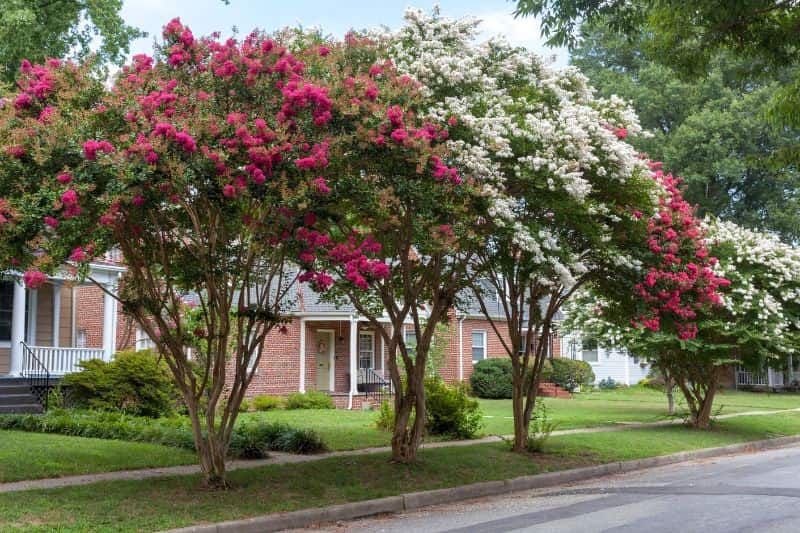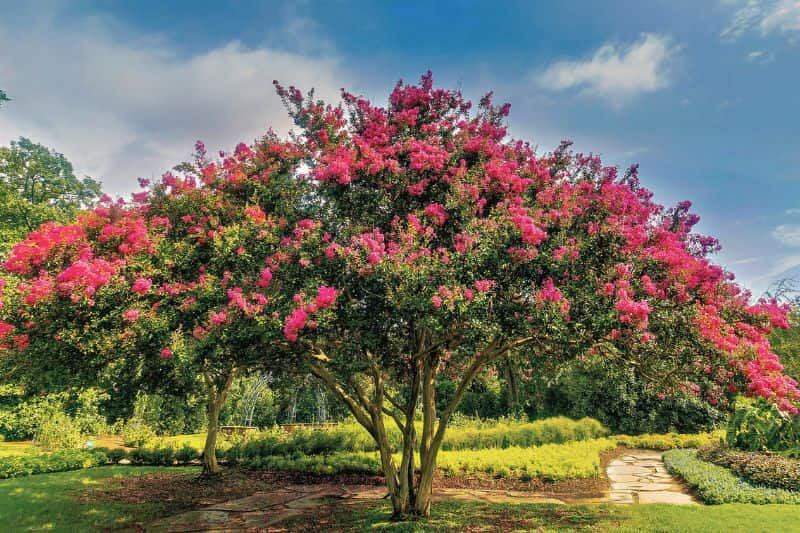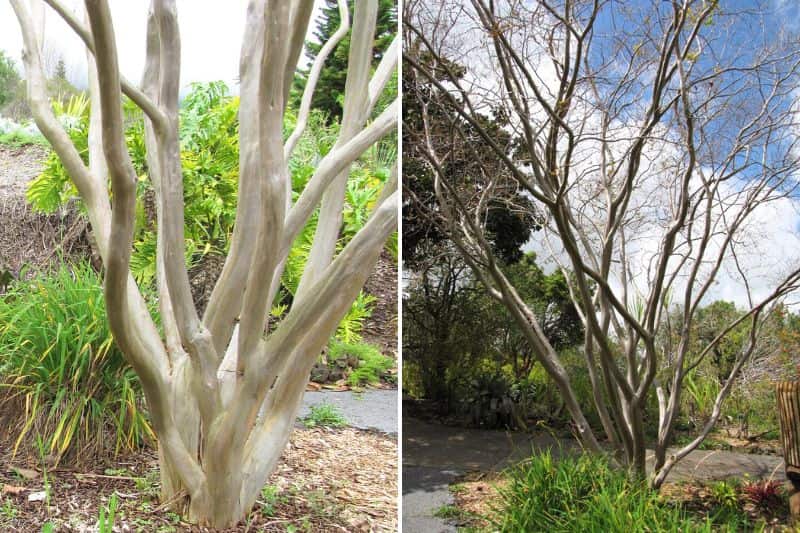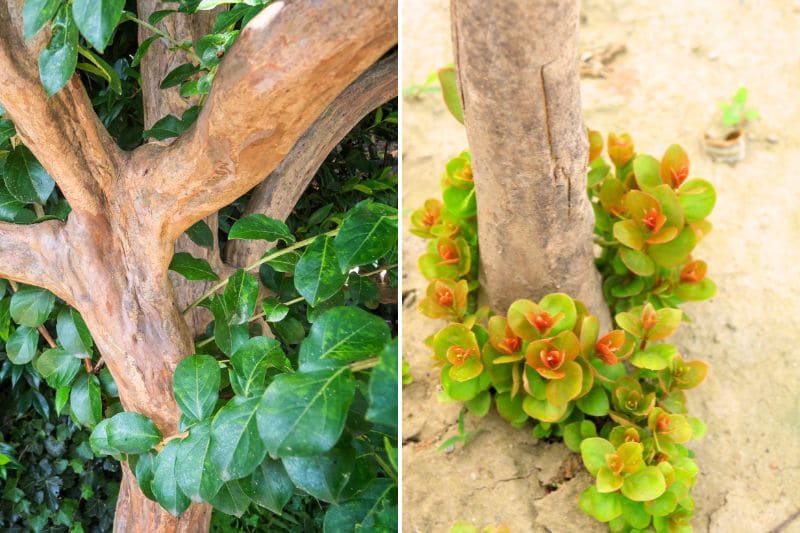Lagerstroemia, commonly known as crape myrtle, is a ornamental bush valued for its magnificent summer flowering, vivid autumn colours and decorative bark. To fully enjoy its beauty, pruning of Lagerstroemia is not obligatory, but it helps maintain an attractive structure, encourage abundant flowering, rejuvenate branches and prevent disease. Discover our tips to help prune your crape myrtle.

Why prune Lagerstroemia?
Pruning crape myrtle has several purposes:
- Shape the bush: Crape myrtle tolerates pruning well and can be trained as coppice shoots (multi-stemmed) or as a standard (single main trunk).
- Promote flowering: Crape myrtle flowers on this year’s wood, i.e. on new shoots. Pruning stimulates production of new branches that will bear flowers. This is especially useful for older specimens that flower little or not at all.
- Maintain an attractive form: regular pruning helps keep a harmonious, balanced silhouette of the bush.
- Remove dead or diseased wood: pruning removes dead, diseased or damaged branches, reducing risk of disease spread.
- Control size: depending on available space, pruning limits height and spread of the bush.
When to prune crape myrtle?
Best time to prune crape myrtle is late winter or very early spring, before active growth begins but after last frosts, generally around March. This period allows pruning without risking damage to new shoots. However, avoid pruning too early, as this could force the plant out of winter dormancy prematurely, leaving it vulnerable to late frosts.
Necessary tools
For pruning you will need:
- A pruning shear : for thin branches and young shoots.
- A lopper or a pruning saw : for thicker branches.
- Gardening gloves : to protect your hands.
- Disinfectant : to clean cutting blades before and after pruning, to prevent disease spread from one plant to another.
- Facultative: wound-sealing compound to protect wounds on large branches and help prevent pests, fungi and disease.

Training a young crape myrtle as coppice shoots (bushy form)
Pruning as coppice shoots is ideal if you want a Lagerstroemia in a bushy form, with several trunks arising from the base. This form gives a natural, generous look, suitable for large gardens or to create a focal point in a border.
Steps to train a Lagerstroemia as coppice shoots:
1- Select main trunks : In the first years of growth, allow 3 to 5 main trunks to develop from the base. Remove other shoots and suckers to encourage strong, balanced growth on the selected trunks.
2- Remove lower branches : Once main trunks are well established, remove small branches growing at the base to concentrate energy in the chosen trunks.
3- Prune to encourage branching : Shorten upper branches slightly to promote better branching. Prune a few centimetres above an outward-facing bud. Each cut stimulates production of new shoots, which will thicken the canopy.
4- Maintain a balanced shape : Prune crossing branches or those growing inward to open the bush and keep a rounded, regular shape.

Training a young crape myrtle as a standard (tree form)
Training a Lagerstroemia as a standard involves creating a single, straight trunk, with a crown of branches higher up. This form is ideal for small gardens or for those wanting a more classic, structured tree look.
Steps to train a Lagerstroemia as a standard:
1- Select the main trunk : As soon as the tree is young, choose a single trunk and remove all other basal shoots. This concentrates energy on that trunk so it becomes robust.
2- Remove lower branches : Gradually remove lateral branches that grow on the first 70 to 100 cm of the trunk. This will clear the stem and give a tree appearance, with a crown forming higher up.
3- Form the crown : Shorten upper branches to encourage branching and create a balanced crown. Ensure shape remains airy and well proportioned around the trunk.
4- Keep the trunk straight : Check trunk growth regularly to ensure it stays straight. If necessary, use a stake in the first years to help maintain alignment.
Annual maintenance of crape myrtle
Once your Lagerstroemia has reached desired form, whether as coppice shoots or as a standard, annual maintenance is necessary to keep shape and encourage abundant flowering. Here are the steps to follow each year, regardless of chosen form.
1. Remove dead or diseased wood
Each year, in late winter or very early spring, start by removing all dead, diseased or damaged branches. Use a pruning shear properly disinfected to cut branches above a healthy bud or at the base. If you find signs of disease, disinfect tools between cuts to avoid spreading infection.
2. Thin to improve air circulation
Whether coppice shoots or standard, thin branches that cross or grow inward. This improves air circulation and reduces disease risk, while allowing light to reach all parts of the plant.
3. Prune to encourage flowering
Lagerstroemia flowers on the new shoots of the year. For this, shorten last year’s branches by one third. This pruning stimulates growth of new shoots that will carry flowers in summer.
4. Remove suckers
Suckers, or drageons, are small shoots that appear at the base of the trunk or on the roots. They should be removed as soon as they appear because they steal energy from the tree and spoil its shape. Use a pruning shear to cut them flush with the ground.

5. Control size
If your Lagerstroemia becomes too large, you can reduce size by shortening main branches of the crown (for a standard) or by reducing overall branches (for coppice shoots). Never cut more than one third of branches at a time to avoid weakening the tree.
9. Finishing and care
After main pruning, do a final inspection to adjust cuts if necessary. Remove all pruned branches and debris from the base of the tree to prevent disease spread. Apply wound-sealing compound to cuts on large branches to protect wounds from pests, fungi and bacterium.
Additional tips
- Do not prune too late in the season : avoid pruning in summer or autumn, as this can stimulate new growth that will not have time to harden before winter, making the plant more vulnerable to frost.
- Do not prune too severely : although severe pruning can sometimes be necessary, it can also weaken the tree and reduce flowering the following year.
































Comments